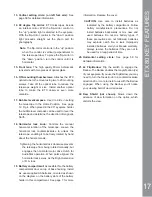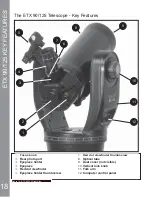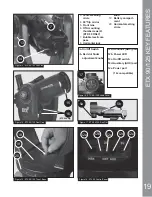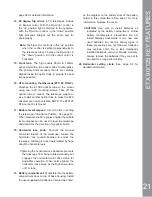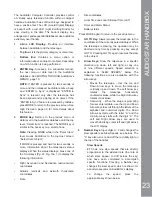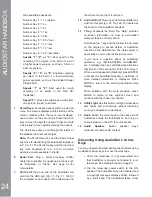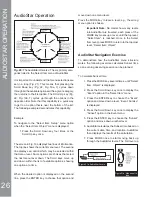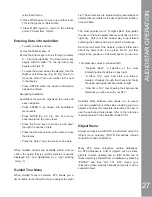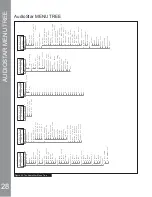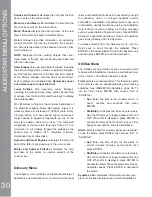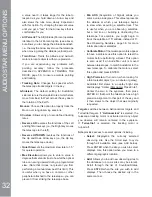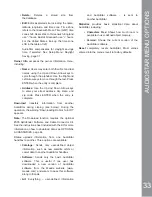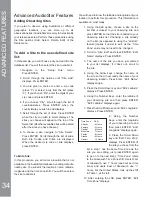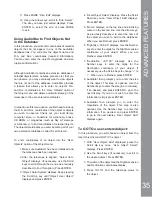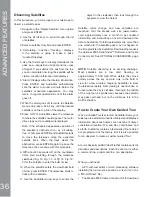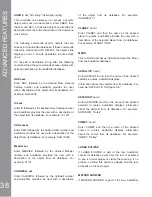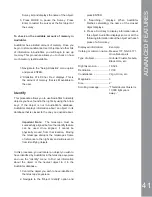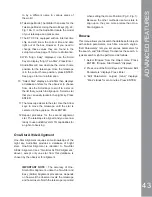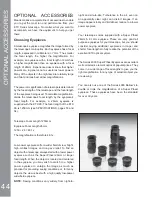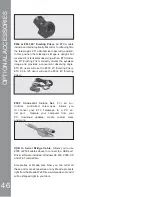
connected.
Field of View:
Scroll through a list of available eye-
SLHFHV:KHQDQH\HSLHFHLVVHOHFWHGWKH¿HOGRI
view is calculated.
0DJQL¿FDWLRQ
Scroll through a list of available
eyepieces. When an eyepiece is selected, the
PDJQL¿FDWLRQLVFDOFXODWHG
• Suggest:
AudioStar calculates and suggests
the best eyepiece for viewing, based on the
telescope and the object being viewed.
•Suggest:
Brightness Adj adjusts the brightness
of the display using the Scroll keys. When
complete, press ENTER.
Contrast Adj
adjusts the contrast of the display using
the Scroll keys. When complete, press ENTER.
Note:
This feature is usually only required in very cold
weather.
Landmark
Survey automatically slews the telescope
WR DOO XVHUGH¿QHG ODQGPDUNV ZLWK D VKRUW SDXVH DW
each location. Press ENTER to start the survey. While
a slew is in progress, press any key to skip that object
and go to the next landmark on the list. To observe
a landmark for a longer period, press MODE when
paused on the object to stop the survey. Press ENTER
WRUHVWDUWWKHVXUYH\DWWKH¿UVWREMHFWRQWKHOLVW6HH
Landmarks, page 40.
Sleep Scope
is a power saving option that shuts down
AudioStar and the telescope without forgetting its
alignment. With “Sleep Scope” selected, press ENTER
to activate the Sleep function. AudioStar goes dark, but
the internal clock keeps running. Press any key, except
ENTER, to re-activate AudioStar and the telescope.
Park Scope
is designed for a telescope that is not moved
between observing sessions. Align the telescope one
time, then use this function to park the telescope. Next
time it is powered up, enter the correct date and time –
no alignment is required. Pressing ENTER causes the
telescope to move to its pre-determined Park position.
Once parked, the screen prompts to turn off power.
Important Note:
When the “Park Scope” option is
chosen and the display prompts you to turn off the
telescope’s power, AudioStar is unable to be returned
to operation without turning the power off and then
back on.
Cord Wrap
, when set to “On”, moves the telescope in
such a way as to prevent the cords and cables attached
to your telescope assembly from getting wound around
the assembly and tangled as the telescope slews to
objects. “Off” is the default setting.
Setup Menu
The Setup menu’s primary function is to align the
telescope. However, there are numerous other features
available within the Setup menu, including:
Date
changes the date used by AudioStar. This function
is useful to check events in the past or future. For
example, set the Date menu for a day three months in
the future. Then check the “Select Item: Event” menu
for the Sunset time on that date. See EVENT MENU,
page 29.
Time
changes the time entered into AudioStar. Setting
the correct time is critical for AudioStar to properly
calculate locations and events. Time may be set to
24-hour mode (military time) by selecting the “blank”
option which follows the “AM” and “PM” options.
Daylight Saving
is used to enable or disable Daylight
Savings time.
Note:
Daylight Savings Time may be referred to by
different names in various areas of the world. Check
local time to verify.
Telescope accesses the several options, including:
• Model:
Allows you to select the telescope
model connected to AudioStar.
• Focal Length:
Displays the focal length of the
selected telescope.
•
Az Ratio and Alt Ratio:
The Az (Azimuth)
ratio and Alt (Altitude) ratio refers to the gears
of the telescope’s motors. Do not alter these
numbers.
•
Az Percent:
The Az (Azimuth) Percent allows
you to change the azimuth backlash, i.e., the
way the Arrow keys move the telescope along
the azimuth (horizontal) axis. If you enter a
value near 100, the telescope tube responds
more quickly (it responds immediately at 100%)
as you hold down an Arrow key and also slews
(moves) the tube more quickly. If you enter
AUDIOST
A
R MENU OPTIONS
31

